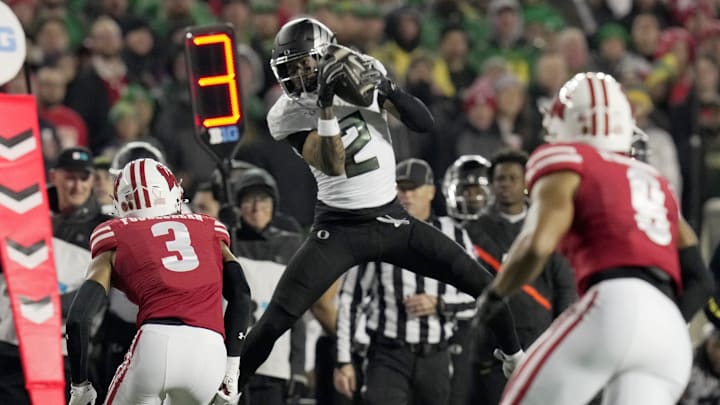People think too narrowly about an injury to a key player. Immediately everyone runs to the depth chart, projecting who is in line to start at X, Y and Z after someone goes down.
Widespread reports say Evan Stewart is down and possibly lost for the season after an injury to his patellar tendon, the strong tendon that connects the shinbone to the knee. A torn patellar tendon typically requires surgery followed by six to 12 months of healing and physical therapy.
No specific diagnoses or treatment plan has been made public in Stewart's case, and the Oregon staff is rarely forthcoming about injuries.
What does it mean for the 2025 season and Oregon's prospects as a Big Ten and national title contender? There's still talent at the wide receiver position.
Stewart's reps and touches will be shared among a talented group of players, including Dakorien Moore, Jeremiah McClellan, Jurrion Dickey, Malik Benson, Cooper Perry, Gary Bryant Jr. and Dillon Gresham. Moore probably emerges early as the big-play, go-to receiver.
The runway is cleared for him and his 10.4 speed.
Of course this requires that these guys get their work done in the classroom and keep themselves eligible.
New wide receiver coach Ross Douglas did a tremendous job at Syracuse last year as passing game coordinator. The Orangemen led the NCAA in passing offense, and Douglas' three principal receivers set career highs.
But Oregon's solution to Stewart's absence will go deeper than merely redistributing the touches at wideout.
Running game and defense
The game plan might shift a little. Particularly early in the year as the coaches wait for a new passing combination to assert itself, the Ducks will rely a little more heavily on a still-potent running game and an improved defense.
They'll vary the tempo more. They'll challenge teams to stop their trio of effective backs, Makhi Hughes, Noah Whittington and Dink Riggs.
Dan Lanning will challenge his offense to execute and take over games, to be explosive and physical. This fits in with the prospect of an improved defense with a tough, deep defensive line.
A strong running game sets up the play-action pass, and deep shots. Moore, Benson and Gresham have the top-end speed to stretch a defense, each a shade faster than Stewart.
Freshman running back Dierre Hill, 6-1, 190, also has 4.4 speed in the 40 and good hands, an all-purpose threat who could be effective on the perimeter. Noah Whittington has strong hands out of the backfield.
Nice picture by @marclebryk of Oregon Duck running back Noah Whittington scoring against the Purdue Boilermakers tonight.
— Chris Pietsch (@ChrisPietsch) October 19, 2024
More coverage of the game from @AlecDietz at @registerguard https://t.co/4aFBEc3229 pic.twitter.com/TZYyMP8KEF
The 2025 defense is going to surprise some people with how physical, intimidating and disruptive it can be. Dillon Thieneman, Bryce Boettcher and Matayo Uiagalelei are going to bring a new personality to the Oregon defense.
The Kenyon Sadiq mystique
Will Stein knows how to build an offense around the weapons he has, and Sadiq will emerge as one of the most effective weapons in college football. His size, speed, and versatility make him a potent target.
No Oregon tight end has had more than 43 catches or 631 yards in a season. Sadiq could shatter those marks.
Top Tight end seasons in college football, 2024
School | Rec | Yds. | YPC | TDs | |
|---|---|---|---|---|---|
Harold Fannin | BGSU | 117 | 1555 | 13.3 | 10 |
Tyler Warren | Penn State | 104 | 1233 | 11.9 | 8 |
Oronde Gasden | Syracuse | 73 | 934 | 12.8 | 7 |
Holden Willis | MTSU | 53 | 871 | 16.4 | 6 |
Tanner Koziol | Ball State | 94 | 839 | 8.9 | 8 |
Source: cfbstats.com
Here’s all 7 catches from Kenyon Sadiq’s spring game today. Look for him to double or even triple his numbers next year. pic.twitter.com/Jyo4xeXKRD
— Mark Kinley (@ONLYSPORTSMK) April 27, 2025
A passing attack of Moore-to-Moore, Sadiq, Gresham, McClellan, and Bryant is not limited. That's a 3,000-yard passing game. Besides that, there's more than one way to win football games.
